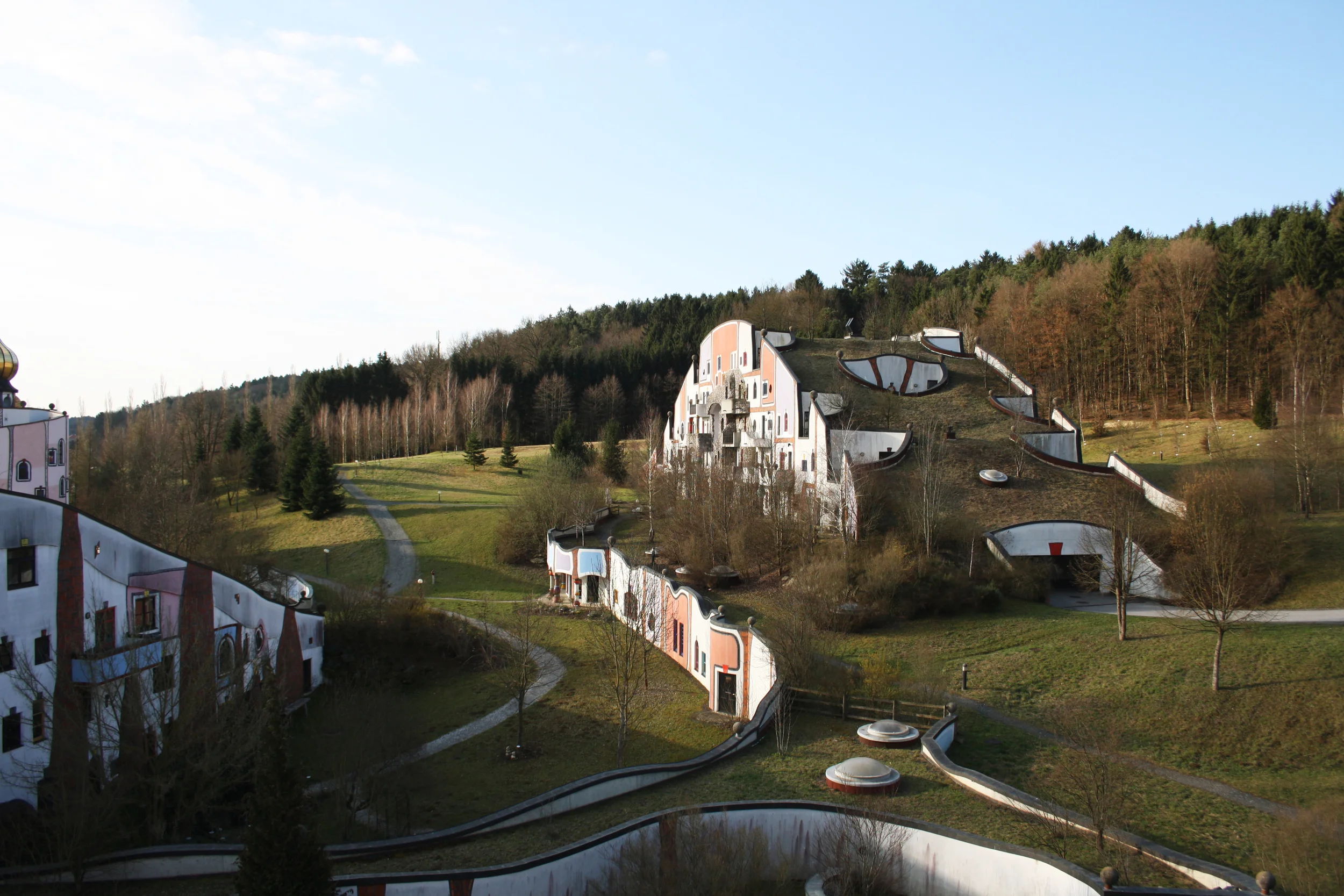Rogner Bad Blumau, Styria, Austria
The Rolling Hills
"Life in harmony with nature", Friedensreich Hundertwasser, Artist/Architect
Hundertwasser painted this in the 1970's. In the 1980's his vision started to become reality.
He saw himself as an Architect Doctor- creatively redesigning already exsting, ugly, "sick" buildings in harmony with nature and individual dreams of man.
In 1989 Hundertwassers dreamy concept for a housing development where the roofs of the buildings were vegetable gardens, rolling meadows and forests was turned into reality- A proposal from builder Robert Rogner to help create and build a hotel and spa resort with the same concept.
Hundertwasser agreed to the development. To him he project would acheive the folllowing-
- life in harmony with nature
- forest and meadow air instead of "concrete air"
- the longing for romanticism and creativity fulfilled
- totally green houses that can be walked upon
- energy saving houses, cool in summer, warm in winter
- more quality of life for neighbours, not just for the residents
- an Austrian way out of the cul-de-sac of city planning- set a precedent worldwide











Thermal Village Blumau
The site
Originally farmland, the site of the Rogner/ Hundertwasser joint project was chosen because the area had a large natural spring deep underground. Initially there were complications in bringing that water up to the surface of the earth.
Today it is the site of Europes only geothermal power station. The water is drilled from 3000m below the earths surface, it is rich with Carbon Dioxide generating 1.1 tons of CO2 per hour. It is used to regulate the pH value of the water at Rogner Bad Blumau, the remainder sold to other local businesses. The process also generates steam which drives a turbine and generator. The result is 190kw of power produced every year. Enough for the resort to be self sufficient.
In conjuntion to the CO2 and power generated the thermal water is also used to heat the entire hotel resort, this saves the resort from needing other heating systems in turn having numerous environmental benefits.
Once the thermal water has served these purposes it is injected back below the earths surface.
The Architecture
Construction began in 1993, the resort was opened in 1997.
The hotel itself consists of about 6 buildings. Each building has its own unique design, they are all partly dug into natural lay of the land, on a slowly inclining hill. The dirt which was excavated for the foundations was placed aside and put back on top of the structure once construction was complete. (This was fundamentally important to Hundertwasser) The result has varying effects. For example looking up towards hotel buildings from the spa area you see each building staggered to overlap one another. However from side on or even on top of the hill looking down you only get glimpses of 'art' popping out of the green country side. As for above looking down- all that can be seen are the green roofs.
Each building is connected to the reception, spa area and restaurants by arcades. Internally these arcades give insight into 2 more Hundertwasser theories.
- Hundertwasser beleived a column resembled a tree. There are 330 columns, each unique in its own right.
- Hundertwasser didn't like straight lines in architecture. He actually beleived that straight lines such as flat floors were 'becoming a true danger to man'. Saying that by building flat floors we were "training" man to become disabled. He beleived an uneven pathway to be a 'symphony for the feet'. As a result the arcade walkways are not level, and the tiles are uneven in places.
The Precedent
As metioned earlier, Hundertwasser believed this project would set a precedent for a new style of construction. Construction that would "unite two things-harmony with nature and individual human creation."
For me it has!
It is inspiring to visit Rogner Bad Blumau from a sustainable architecture perspective.
(It is also extremely relaxing from a spa resort perspective. If relaxing by the pool, eating some great Austrian food, or drinking Austrian beer interest you, then you will also be inspired here.)
To book a stay... or for more information on the architecture and philoshy of Blumau go to www.blumau.com



